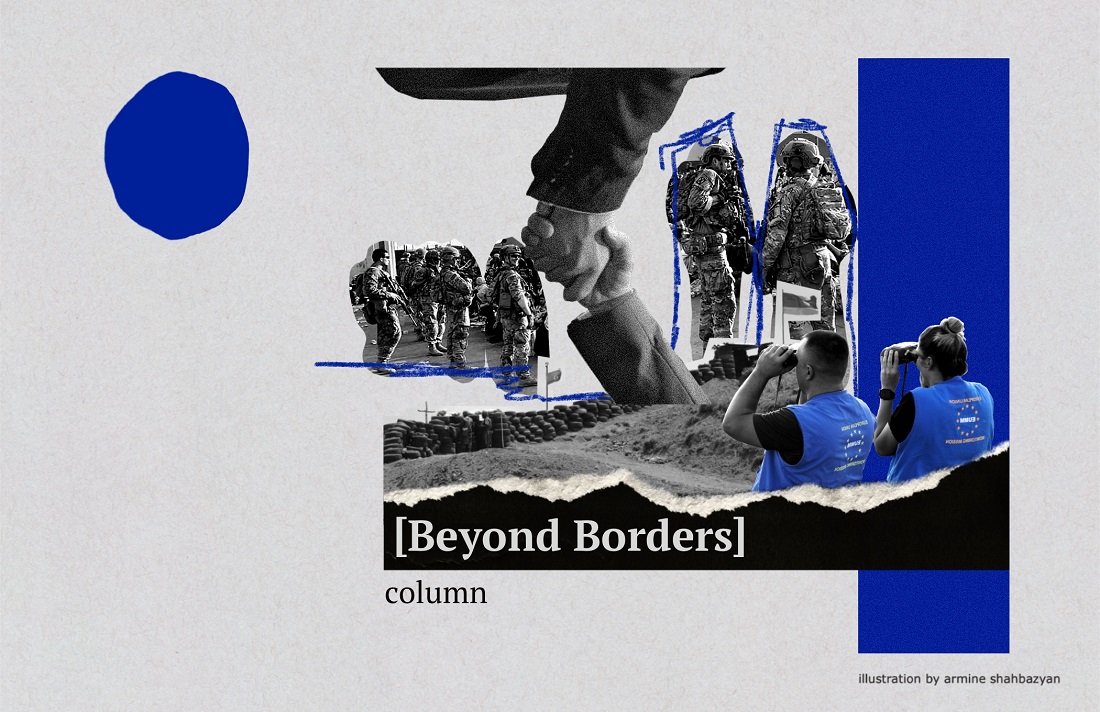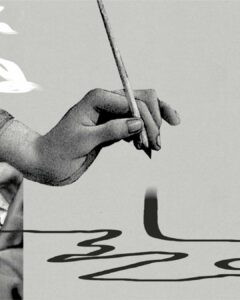[Beyond Borders]
This column explores the key issues shaping life in the South Caucasus, focusing on how the divergent paths of Georgia, Armenia and Azerbaijan reflect the region’s complex histories, economic developments, and political shifts. While new generations in these countries grow more isolated from one another due to language barriers and conflicting national trajectories, the same is true for local policymakers, who are often more familiar with distant capitals than their immediate neighbors. Each nation seeks its own path, sometimes in conflict with others, while international actors often treat the region as a whole, reluctant to craft policies specific to individual states. Drawing on personal experience with the region’s revolutions, conflicts and transformations, Olesya brings you Beyond Borders—a column exploring how decisions made in one corner of the South Caucasus impact all who live there.

Listen to the article.
Following Azerbaijan’s 2022 attack on Armenia, the EU quickly deployed a civilian mission to monitor the situation along the tense border. While the mission has helped to maintain a fragile calm, Azerbaijan has made its removal one of the conditions for progress in peace talks, putting at risk the very stability it was meant to uphold. In an attempt to keep negotiations alive, Armenia has suggested that third-party observers will no longer be necessary in sections of the border that have already been demarcated. While this move might appear pragmatic, it risks undermining the mission’s broader mandate and diluting its role as a deterrent to aggression.
For the residents of Armenia’s borderlands, EU vehicles adorned with blue flags and yellow stars have become a routine presence. From afar, news reports occasionally document the high-profile visits of foreign dignitaries to the frontier—not merely to marvel at the austere beauty of the mountain terrain punctuated with military fortifications, but to signal steadfast support for the EU’s mission in Armenia, known as EUMA.
The EU’s decision to deploy this mission came in the wake of Azerbaijan’s devastating assault on Armenia in September 2022. What began as a modest observation team swiftly evolved into a robust operation tasked with monitoring the fraught Armenian-Azerbaijani border. When Azerbaijan seized Nagorno-Karabakh in 2023, Brussels strengthened the capacity of EUMA, increasing its presence in the region to over 160 observers from 25 of the EU’s 27 member states.
At first, the border’s inhabitants struggled to grasp the nature of this new European presence. Unlike the Russian forces they had long known, EU observers arrived as civilians—traveling in cars emblazoned with the Union’s insignia, armed not with rifles but with binoculars. Their power lay not in their military might, but in the credibility of their reports, relayed to European capitals to inform diplomatic strategies aimed at de-escalation.
Yet, the mission’s credibility now faces uncertainty. Since summer, Azerbaijan has demanded EUMA’s withdrawal as a prerequisite for a peace deal, branding its presence an obstacle to meaningful negotiations. Last week, Azerbaijan’s president dismissed the EUMA as a “NATO mission”. His remarks, aired on Russian state television, seemed crafted for Moscow’s audience. Armenia’s leader, in response, signaled openness to discussions about the mission by proposing that observers may not be needed on the demarcated sections of the border. While Yerevan’s stance reflects a willingness to negotiate, it also reiterates demands for Azerbaijan to withdraw its troops from strategic positions deep inside Armenian territory, particularly near Jermuk, Vardenis, and the village of Nerkin Hand near Kapan.
When political actors openly question the mandate of civilian monitors, credibility begins to erode. History offers a cautionary tale: similar missions elsewhere faltered once sides began debating their mandates. Doubts can metastasize, weakening trust in the mission’s findings and diminishing its deterrent power. Worse, this erosion could embolden the sides, signaling a tacit indifference to whether the mission remains in place at all. In moments of crisis, when EUMA is called upon to provide crucial reports, skepticism might not remain confined to the region—it could ripple across European capitals, delaying or derailing diplomatic responses.
Azerbaijan’s Relentless Campaign
The EU mission’s mandate, set to expire in February 2025, faces a sustained campaign from Azerbaijan to block its renewal. Despite Baku’s persistent efforts, they are unlikely to yield any results. The mission has passed the requisite verification processes, securing its renewal, much like EUMA’s sibling mission in Georgia—EUMM—which had its mandate extended earlier this month. The EUMA’s renewal is expected to follow suit, though Azerbaijan remains unrelenting in its opposition.
Why this unyielding campaign? On one level, it seeks not just to oppose the mission but to craft a broader narrative supporting Azerbaijan’s position, both domestically and internationally. Recently, Azerbaijani state-linked media began releasing videos documenting EUMA’s border visits. While the footage itself seems innocuous, the accompanying commentary often paints the mission as engaged in covert operations—spying or aiding Armenian forces—clouding its work with suspicion. The strategy is clear: discredit EUMA to such an extent that external observers, including EU policymakers, question its legitimacy.
This antagonism is not new but has grown louder. President Aliyev has occasionally claimed that he personally approved EUMA’s initial deployment in 2022, framing it as a calculated concession. But as Brussels deepened its engagement with Armenia, tensions with Baku sharpened.
The EU, for its part, has walked a diplomatic tightrope, striving to keep Azerbaijan within its orbit. It floated numerous proposals before deploying EUMA, including one that would have placed EU observers on the Azerbaijani side of the border. Baku, fiercely protective of its sovereignty, rebuffed these suggestions, much as it insisted on the withdrawal of Russian peacekeepers from Nagorno-Karabakh.
Another overture involved stationing a senior EUMA representative in Baku to liaise with Azerbaijani officials. Though this idea remains on the table, Azerbaijan expressed dissatisfaction, citing the EU representative’s insufficient rank. A further proposal envisioned using EUMA to facilitate border incident discussions between Armenia and Azerbaijan, but Baku dismissed this too.
Currently, the EU mission communicates with Azerbaijan only via weekly updates sent through the EU Special Representative’s office, detailing planned observation trips. These updates aim to minimize risks to EU observers traveling along military positions, but Azerbaijan offers no acknowledgment, much less cooperation.
Unable to sway Brussels directly, Azerbaijan has turned its attention to Armenia, pressuring the country—the mission’s formal host—to reconsider its support for EUMA. Armenia remains reluctant to let the mission lapse. It appears, however, that Yerevan is tacitly appeasing Aliyev’s attempt at entrapment by allowing for contextual ambiguity around the conditions for maintaining EUMA’s ongoing presence.
Armenia’s Delicate Balancing Act
The EU’s rapid deployment of observers in 2022 marked a watershed moment, showcasing Brussels’ ability to mobilize resources in a region dominated by Russian influence. For Armenia, grappling with depleted military capabilities after its 2020 defeat, EUMA serves as a critical safeguard against Azerbaijani aggression. The very presence of EU observers, whose reports to member states ensure close monitoring of the situation, acts as a deterrent, signaling that any military action by Baku would come at a significant diplomatic and political cost, with Europe unlikely to stand by passively.
Yerevan’s response to Baku’s demands underscores its desire to retain the mission. As noted earlier, Armenia has proposed limiting EUMA’s presence to areas where border delimitation remains incomplete—currently only a narrow 12-kilometer stretch out of around 1000 kilometers. Given the extensive length of the border, the delimitation process would inevitably take considerable time, even if Azerbaijan were to demonstrate genuine goodwill to advance the negotiations.
The calculus appears straightforward: Armenia hopes to maintain EUMA’s support while awaiting Azerbaijan’s withdrawal from sensitive territories like Jermuk, a key position from which Azerbaijan could potentially advance deeper into Armenian territory, threatening to cut the country into two parts. Yet, by entertaining the notion of scaling back the mission, Yerevan risks signaling to some EU members that its presence and mandate might be negotiable.
Armenia’s vulnerability is evident. It navigates an unequal power dynamic with its stronger neighbor, while juggling the expectations of external actors. Once seen as a neutral mediator, the EU mission has been increasingly sidelined as Yerevan and Baku began pursuing bilateral negotiations a year ago.
Whether consciously or not, Armenia’s ambivalence has sometimes further marginalized EUMA. Earlier this year, Yerevan proposed direct communication with Azerbaijan to prevent border incidents, echoing pre-2020 mechanisms that had helped maintain calm along frontlines. When Baku ignored the offer, one EU official reminded the sides that facilitating such dialogue fell within EUMA’s mandate. Armenia, however, let the matter lapse.
Similarly, during border demarcation talks, Armenia reportedly asked EUMA to steer clear of demarcation zones, fearing their presence might provoke Azerbaijan. Though temporary, the exclusion contributed to impressions of a more limited role for the mission..
Time for Europe to Lead
Armenia must not falter in defending the mission’s interests, and the European Union should unequivocally assert EUMA’s value as a stabilizing force. Armenia has a clear interest in maintaining the mission’s presence. Even Azerbaijan, despite its entrenched opposition, might find opportunities to rebuild trust with its important trade partner through incremental engagement with its mission—for example, by considering one of the cooperation approaches the EU had suggested in earlier proposals.
The stakes for Europe are significant. Allowing EUMA to falter without a strong defense would damage the EU’s credibility in the South Caucasus. At worst, such a failure could render Brussels irrelevant in addressing the region’s most pressing diplomatic challenges.


